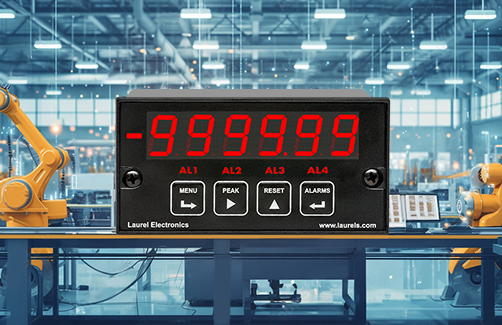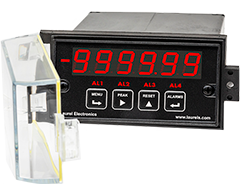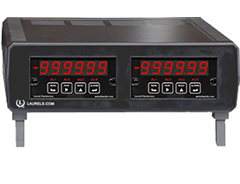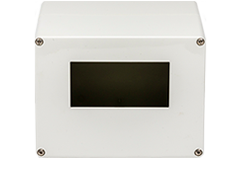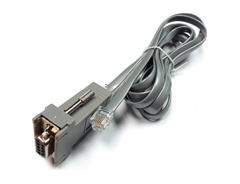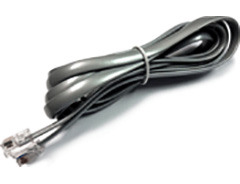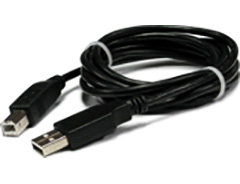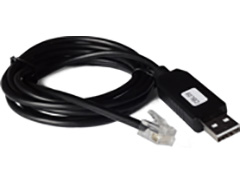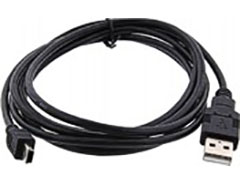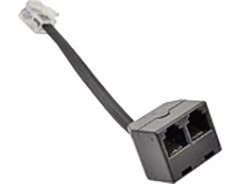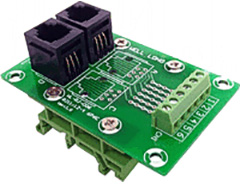Features
- Accepts RS232, RS485 or USB streaming data
- Accuracy of 0.01% of reading ± 2 counts
- Able to extract readings embedded in ASCII data strings
- Displays 6-digit numeric readings with any decimal point
- Up to 60 conversions per second, Ideal for peak or valley capture
- Digital span adjust from 0 to ±99,999, zero adjust from -99,999 to +99,999
- Front panel scalable to ±99,999 for use with current shunts
- 1/8 DIN size with bright red or green 0.56" (14.2mm), high LED digits
- Power 85-264 Vac / 90-300 Vdc or 10-48 Vdc / 12-32 Vac (isolated)
- Operating temperature from -40°C to 70°C (-40°F to 158°F)
- Wide choice of Plug-in-Play options:
- 2 or 4 relays, mechanical or solid state, for alarm or control (isolated)
- 1 or 2 Analog output, 4-20 mA, 0-20 mA, 0-10V, or -10V to +10V (isolated)
- Communications: Ethernet, WiFi, USB, RS232, RS485 (isolated)
Laureate™ 1/8 DIN Digital Panel Meter Remote Displays
(or Serial Input Meters) are slave displays which accept RS232, RS485 or USB data from computers, programmable controllers, Laureate instruments, or other devices with a streaming serial data output. They can also provide relay closures and an analog output based on the received readings. They blend in with 1/8 DIN Laureate digital panel meters, counters and timers to provide a numeric 6-digit display from -999,999 to +999,999.
All signal conditioner board ranges are factory-calibrated, with calibration factors for each range securely stored in an onboard EEPROM. These factors can be scaled via software to accommodate external shunts, enabling field replacement of signal conditioner boards without necessitating recalibration of the associated digital panel meter. For optimal accuracy, factory recalibration is recommended annually. All Laurel Electronics instruments undergo factory calibration using the industry-leading Fluke calibrators, which are recalibrated yearly and certified traceable to national standards, ensuring the highest level of precision and reliability.
Streaming serial data can be generated at rates up to 9600 baud by a weighing scale or other instrument. In particular, it can be generated by a Laureate digital panel meter, counter/timer or transmitter. A Remote Display can duplicate the reading of that instrument, or it can be used to display additional data items which can be transmitted serially, but which cannot be shown simultaneously on a single display. For example, while a Laureate counter can only display one selected parameter at a time (such as rate A), it can transmit multiple parameters (such as rate A, rate B, ratio A/B and peak). The Remote Display can be set up to display any serially transmitted item, and an indicator light shows which item has been chosen for display.
Setup of the Remote Display uses Laurel’s free Instrument Setup Software. Selectable modes allow easy interface to other Laureate instruments and extract 1, 2 or 3 data items. For other instruments, readings can be extracted from streaming ASCII strings that contain multiple data values and non-numeric characters, such as Start and Stop characters. Any number of characters between the Start character and the data can be masked Off. Up to 8 display characters (including sign and decimal point) can be masked On. Any number of characters between the last displayed character and the Stop character can be masked Off.
An optional (isolated) analog output board allows the Remote Display to serve as a highly accurate digital-to-analog converter and transmitter.
An optional relay output board with 2 or 4 relays can add remote alarm or control capability. The relays can be 8A contact relays or opto-(isolated) 120 mA AC/DC solid state relays. The relays can respond to the transmitted values or to any of 8 serially transmitted control characters. The control characters can be generated by a Laureate meter, counter or timer, thereby assuring that the local and remote alarm points are identical.
Modular Design for Maximum Flexibility at Minimum Cost
All boards are isolated from meter and power grounds. Optional Plug-in-Play boards for communications and control include Ethernet, WiFi, serial communication boards, dual or quad relay boards, and an analog output board. Laureates may be powered from 85-264 Vac or optionally from 12-32 Vac or 10-48 Vdc. The display is available with bright red or green 0.56" (14.2mm) high LED digits. The 1/8 DIN case meets NEMA 4X (IP65) specifications from the front when panel mounted. Any setup functions and front panel keys can be locked out for simplified usage and security. A built-in 5, 10, 12, or 24 Vdc excitation supply can power transducers, eliminating the need for an external power supply. All power and signal connections are via UL / VDE / CSA rated screw clamp plugs.
The Laureate™ Series features modular design with up to 7 isolated plug-in boards, applicable to all Laureate 1/8 DIN Digital Panel Meters.

Modular Hardware
The design of the Laureate™ Series is modular for maximum flexibility at minimum cost. All boards are isolated from meter and power grounds. The base configuration for a panel meter or counter consists of a main module (with computer and plug-in display boards), a power supply board, and a signal conditioner board. Optional plug-in-play boards include an isolated setpoint controller board, an isolated analog output board, and an isolated digital interface board. Modular design and a choice of plug-in options allow the Laureate to be customized for a broad range of applications from simple monitoring to control and computer interface. There can be up to five plug-in boards in a 1/8 DIN Laureate.

Connecting Laureate Digital Panel Meters to a Local Area Network (LAN)
Up to 30 Laureate Digital Panel Meters and/or LT Transmitters can be configured for RS485 and daisy-chained to an LT Transmitter using Laurel’s High Speed Ethernet-to-RS485 converter board for seamless LAN integration. Alternatively, Laurel LTE series Ethernet transmitters can connect directly to a LAN via an Ethernet cable. Setup for both configurations is streamlined using Laurel’s free Instrument Setup Software, which simplifies node discovery and transmitter configuration.
Flexible Communication Options for Digital Panel Meters
Laureate Digital Panel Meters can be equipped with Laurel communication boards to support various interfaces and protocols. These include serial interfaces with ASCII or Modbus RTU protocols, and Ethernet interfaces with web access, ASCII, or Modbus TCP/IP protocols, ensuring versatile connectivity for your commercial applications.

| Display | |||
|---|---|---|---|
| Readout | 6 LED digits, 7-segment, 14.2 mm (.56"), red or green. | ||
| Range | -999999 to +999999 | ||
| Indicators | Four LED lamps | ||
| * Range not ETL certified. | |||
| Recalibration: All ranges are calibrated at the factory. Recalibration is recommended every 12 months. | |||
| Power | |||
| Voltage, standard | 85-264 Vac or 90-300 Vdc | ||
| Voltage, optional | 12-32 Vac or 10-48 Vdc | ||
| Frequency | DC or 47-63 Hz | ||
| Power consumption (typical, base meter) | 1.2W @ 120 Vac, 1.5W @ 240 Vac, 1.3W @ 10 Vdc, 1.4W @ 20 Vdc, 1.55W @ 30 Vdc, 1.8W @ 40 Vdc, 2.15W @ 48 Vdc | ||
| Power Isolation | 250V rms working, 2.3 kV rms per 1 min test | ||
| Serial Interface (one required) | |||
| Board selections | RS232, USB, RS485 (dual RJ11), RS485 (dual RJ45), | ||
| ASCII data rates | 300 to 9600 baud | ||
| Isolation | 250V rms working, 2.3 kV rms per 1 min test | ||
| Analog Output (optional) | |||
| Output levels | 4-20 mA, 0-20 mA, 0-10V, -10 to +10V | ||
| Current compliance | 2 mA at 10V ( > 5 kΩ load) | ||
| Voltage compliance | 12V at 20 mA (< 600Ω load) | ||
| Scaling | Zero and full scale adjustable from -99999 to +99999 | ||
| Resolution | 16 bits (0.0015% of full scale) | ||
| Isolation | 250V rms working, 2.3 kV rms per 1 min test | ||
| Relay Outputs (optional) | |||
| Dual magnetic relays | 2 Form C, 8A max, 440Vac or 125Vdc max, 2500VA or 300W | ||
| Quad magnetic relays | 4 Form A (NO), 8A max, 440Vac or 125Vdc max, 2500VA or 300W | ||
| Dual solid state relays | 2 Form A (NO), AC or DC, 0V - 400V, 120Ma, 35Ohms (max at On-State) | ||
| Quad solid state relays | 4 Form A (NO), AC or DC, 0V - 400V, 120Ma, 35Ohms (max at On-State) | ||
| Relay commons | Isolated commons for dual relays or each pair of quad relays | ||
| Relay isolation | 250V rms working, 2.3 kV rms per 1 minute test | ||
| Relay latching modes | Latching or non-latching | ||
| Relay active modes | Active on or off, active high or low | ||
| Hysteresis modes | QA passband mode, split hysteresis, span hysteresis | ||
| Environmental | |||
| Operating temperature | -40°C to 70°C (-40°F to 158°F) | ||
| Storage temperature. | -40°C to 85°C (-40°F to 185°F) | ||
| Relative humidity | 95% at 40°C, non-condensing | ||
| Protection | NEMA-4X (IP-65) when panel mounted | ||
| Mechanical | |||
| Enclosure | 1/8 DIN, high impact plastic, UL 94V-0, color: black | ||
| Mounting | 1/8 DIN panel cutout required: 3.622" x 1.772" (92 mm x 45 mm). | ||
| Dimensions | 4.68" x 2.45" x 5.64" (119 mm x 62 mm x 143 mm) (W x H x D) | ||
| Maximum panel thickness | 4.5 mm (0.18") | ||
| Tightening Torque - Connectors | Screw terminal connectors: 5 lb-in (0.56 Nm) | ||
| Tightening Torque - Pawls | Digital Panel Meter Case Pawls: 5 lb-in (0.56 Nm) | ||
| Weight of base meter | 210 g (7.4 oz) typical (DPM, counter, timer, 6-digit remote display) | ||
| Weight of option boards | 30 g (1.0 oz) typical per board (analog output, relay output, communications) | ||
| General | |||
| Programming Methods | Four front panel buttons or via Laurel's free Instrument Setup Software, which runs on a PC under MS Windows. | ||
| Security | Lockout options include using the front panel buttons, the free Instrument Setup Software, or a hardware jumper. | ||
| Warranty | 3 years parts & labor | ||
| Recalibration: All ranges are calibrated at the factory. Recalibration is recommended every 12 months. | |||
Free Instrument Setup Software for Series 2 Laureates
Free Downloadable Windows-based Instrument Setup (IS) software (Data Interface Board Required) for use with our programmable Digital Panel Meters, Scale Meters, Counters, Timers, Remote Displays, and Transmitters, are an easy method to set up Laureate 1/8 DIN digital panel meters, counters, timers, remote displays, and DIN-rail transmitters, as explained in the Instrument Setup Software Manual. Laureate 1/8 DIN instruments can also be set up from the front panel, as explained in their respective Owners Manuals. Instrument Setup software is of benefit whether or not the PC is connected to the instrument.
- When the PC is connected to the instrument, Instrument Setup software can retrieve the setup file from the instrument or open a default setup file or previously saved setup file from disk View Setup, then provides graphical user interface (GUI) screens with pull-down menus applicable to input, display, scaling, filtering, alarms, communications, analog output, and front panel lockouts. Fields that are not applicable to the instrument as configured are either left out or grayed out. Clicking on any item will bring up a detailed Help screen for that item. After editing, the setup file can be downloaded, uploaded to the instrument, or saved to a disk. The same setup file can then be downloaded into multiple instruments.
- When the PC is not connected to the instrument, the above GUI screens can be used to set up a virtual instrument. The setup file can then be saved to disk. Switching toView Menu then brings up a screen with the required front panel programming steps. This view can be printed out for use at the instrument site and to serve as a hard copy record.
Download Free Instrument Setup Software
Installation
Set User Account Control (UAC) of MS Windows to "Never notifiy me" so that Instrument Setup Software can create directories. The UAC change screen can be reached as follows:
- Under Windows 7, click on the Windows Start button in the lower left of the desktop and enter "UAC" in the search field.
- Under Windows 8, navigate to Control Panel, then to the "User Accounts and Family Safety" section, and click on "Change User Account Control Settings."
- Under Windows 10, click on the Windows Start button in the lower left of the desktop, then on "Settings", and enter "UAC" in the search field.
- Reboot your computer for the changed UAC setting to take effect.

RJ11-to-DB9 cable with rear view of DB9 connector to PC

RS232 cable, meter to PC, P/N CBL01
Laureate 1/8 DIN Laureate instruments must be equipped with a serial communications board and be connected to the computer via a serial communications cable. The connection can be via RS232, RS485, USB or Ethernet. Following setup, the serial communications board may be removed from the instrument if desired. The wiring of the RS232 cable is illustrated above with end views of the two connectors.
Laureate LT Series transmitters come standard with a 3-wire serial interface, which can be jumpered for RS232 or RS485.
Laureate LTE Series transmitters come standard with an Ethernet interface.
Meter Setup Screens
Click on any of the reduced screens below for a full-size screen view, then click on the Back button of your browser to return to this page. The screens examples below are for a fully-loaded Series 2 Digital Panel Meter (DPM), which is connected to the PC via RS232. If the meter is a Series 1 meter (pre-2007), this is sensed by the software, and somewhat different screens are brought up. Please see Series 1 setup screens.











Meter Setup Utilities




From the Main Menu, click on Readings if your PC is connected to the meter. A pull-down menu then offers three choices: List, Plot and Graph.
- List presents the latest readings in a 20-row by 10-column table. Press Pause at any time to freeze the display. This is one method to capture peak readings.
- Plot generates a plot of readings vs. time in seconds. It effectively turns the DPM-PC combination into a printing digital oscilloscope.

- Graph generates a histogram where the horizontal axis is the reading and the vertical axis is the number of occurrences of readings. The display continually resizes itself as the number of readings increases.



Laureate™ 1/8 DIN Case For Laureate Digital Panel Meters, Counters, Timers & Remote Displays
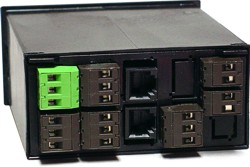
Key Features
- Meets 1/8 DIN Standard.
- Installs from front of panel.
- Short depth behind the panel: only 4" (102 mm) plus connectors.
- Understated 0.157" (4 mm) thick bezel.
- Meets NEMA 4X (IP-65) for high-pressure wawshdon when panel mounted.
- Screw clamps connectors meet VDE / IEC / UL / CSA safety standards.
- Rugged GE Lexan® housing material.
- Safety certified per EN 61010-1.
Dimensions
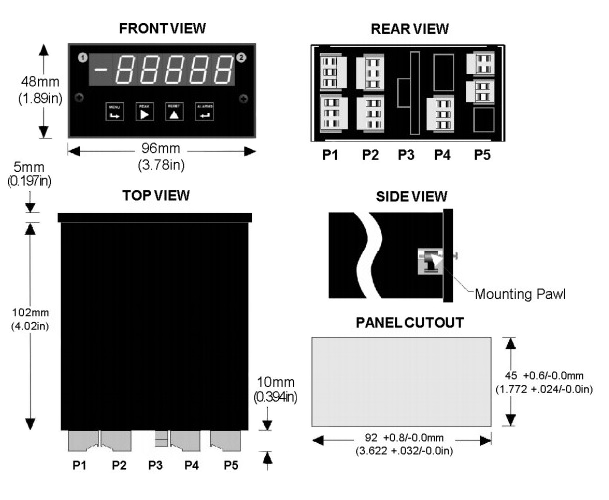
Maximum panel thickness: 4.5 mm (0.18")
Weight of base meter: 210 g (7.4 oz) typical (DPM, counter, timer, 6-digit remote display)
Weight of option boards: 30 g (1.0 oz) typical per board (analog output, relay output, communications)
Tightening Torque - Connectors: Screw terminal connectors: 5 lb-in (0.56 Nm)
Tightening Torque - Pawls: Digital Panel Meter Case Pawls: 5 lb-in (0.56 Nm)
Dimensioned CAD assembly drawings in EPRT, STEP, x_t. dwg, pdf file formats: Laureate-meter-case.zip (zipping prevents browser from opening CAD files as text files).
Panel Mounting
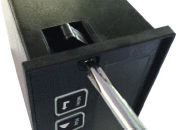 Slide the meter into a 45 x 92 mm 1/8 DIN panel cutout. Ensure that the provided gasket is in place between the front of the panel and the back of the meter bezel.
The meter is secured by two pawls, each held by a screw, as illustrated. Turning each screw counterclockwise extends the pawl outward from the case and behind the panel. Turning each screw clockwise further tightens it against the panel to secure the meter.
Slide the meter into a 45 x 92 mm 1/8 DIN panel cutout. Ensure that the provided gasket is in place between the front of the panel and the back of the meter bezel.
The meter is secured by two pawls, each held by a screw, as illustrated. Turning each screw counterclockwise extends the pawl outward from the case and behind the panel. Turning each screw clockwise further tightens it against the panel to secure the meter.
Turning each screw counterclockwise loosens the pawl and retracts it into its well. This position allows installed meter to be removed from their panel, or new meters to be installed in a panel. Do not remove the screws from their pawls. Doing so would cause the screw and pawl to fall off and likely get lost. Do not overtighten so as not to damage the plastic parts.
| Duty Cycle & Pulse Width Modulation (PWM) Modes | |
|---|---|
 |
|
| Monitoring Laser OperationPM and Speed | |
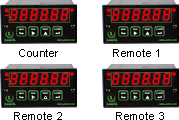 |
The display of a Laureate counter can be augmented by up to three slave displays to show up to four parameters simultaneously : Items #1, #2, #3 and peak rate (if rate was one of the selected items). All four parameters can also be displayed at a remote location. |
IPC
Splashproof Cover
CLB01
RS232 Cable for Meters
CLB02
USB-to-RS232 Adapter Cable
CBL04
RS232 Cable for LT Transmitters
CLB05
USB Data Cable for Meters
CLB06
USB-to-RS485 Adapter Cable
CLB07
USB Programming & Data Cable
CLB08
RS485 Splitter Cable
BKBD
RS485 RJ11 Terminal Block Adapter
What is a Digital Panel Meter for Serial Input 6-Digit Panel Meter and Remote Display?
A digital panel meter for serial input 6-digit panel meter and remote display is a precision instrument designed to receive and display data transmitted via serial communication protocols, such as RS-232, RS-485, or Modbus, from remote devices like sensors, PLCs, or other meters. These meters are critical in industrial, automation, and process control applications where centralized or remote monitoring of data, such as process variables, counts, or measurements, is essential. With a high-resolution 6-digit display, digital panel meters provide clear and accurate readouts for applications like process monitoring, data logging, and system diagnostics.
Unlike traditional analog meters, these digital panel meters offer advanced functionality, including the ability to act as remote displays for data from other systems, programmable features, and seamless integration with industrial networks. Their high-resolution displays and serial input capabilities make them ideal for applications requiring precise data visualization and centralized control in complex environments.
Understanding the Digital Panel Meter for Serial Input and Remote Display
Digital panel meters for serial input and remote display applications are typically built to the 1/8 DIN standard, fitting compactly into panel cutouts approximately 96 mm x 48 mm. This compact size ensures compatibility with control panels while optimizing space, making them suitable for industrial control rooms, production lines, or equipment with limited space.
These meters are designed to receive data via serial communication protocols, interpreting and displaying values like process measurements, totals, or status information from remote devices. The 6-digit display provides high resolution for precise readouts, capable of showing large numerical values or detailed data. They feature bright LED or LCD displays, user-friendly interfaces, and communication options like Ethernet, RS-232, or RS-485 for integration with automation systems. Advanced features, such as programmable scaling, data formatting, and alarm settings, ensure reliable performance in diverse applications.
How Does a Digital Panel Meter for Serial Input and Remote Display Work?
A digital panel meter processes serial data from remote devices to display measurements or status, providing accurate and high-resolution readouts. Below is a detailed breakdown of its operation:
- Data Acquisition:
The meter receives serial data packets from a remote device, such as a PLC, sensor, or another meter, via a communication protocol like RS-232, RS-485, or Modbus. The data may represent process variables, counts, or other measurements. - Data Parsing:
The meter decodes the serial data, extracting relevant values based on the configured protocol and data format (e.g., ASCII, binary). This step ensures accurate interpretation of the transmitted information. - Data Processing:
The microcontroller processes the decoded data, applying scaling, unit conversions, or formatting as needed to convert raw values into meaningful measurements (e.g., temperature in °C, flow in liters). - Display:
The processed data is displayed on a 6-digit digital screen, offering high resolution for precise readouts. The display can show numerical values, status indicators, or alternating data points, with customizable units or decimal precision. - Output and Integration:
The meter may provide outputs like relay contacts for alarms or control, analog signals for feedback, or additional serial communication to relay data to other systems, ensuring seamless integration with industrial networks. - Configuration:
Users can configure the meter to support specific serial protocols, baud rates, data formats, or alarm thresholds, tailoring it to the application’s requirements.
Key Features of Digital Panel Meters for Serial Input and Remote Display
Digital panel meters for serial input and remote display applications include features that enhance performance and usability:
- High-Resolution Display: 6-digit displays provide precise readouts, supporting large numerical values or detailed data.
- Serial Protocol Support: Compatibility with protocols like RS-232, RS-485, or Modbus ensures versatility for various industrial systems.
- Customizable Displays: Multi-color LEDs or large-digit displays ensure readability in various lighting conditions.
- Programmable Alarms and Control: Setpoints for displayed values trigger alerts or control external devices, such as alarms for out-of-range conditions.
- Communication Options: Support for Ethernet or serial interfaces enables integration with industrial automation systems.
- Rugged Design: Dust- and moisture-resistant front panels ensure durability in harsh industrial environments.
Applications of Digital Panel Meters for Serial Input and Remote Display
Digital panel meters are widely used for serial input and remote display functions in various applications. Key uses include:
- Process Monitoring:
In industrial systems, DPMs display process variables like temperature, pressure, or flow from remote sensors via serial communication, enabling centralized monitoring. - Data Logging:
In automation systems, digital panel meters display and relay serial data from PLCs or data loggers, supporting real-time data analysis and record-keeping. - Remote Display:
In control rooms, DPMs act as remote displays for data from distant sensors or meters, providing operators with clear, centralized readouts. - Production Tracking:
In manufacturing, digital panel meters display production counts or totals from remote counters, aiding in performance monitoring and inventory management. - System Diagnostics:
In industrial networks, DPMs display diagnostic data from remote devices, helping technicians monitor system health and troubleshoot issues.
Where Are Digital Panel Meters for Serial Input and Remote Display Used?
Digital panel meters are essential in industries requiring precise data display from serial inputs. With support for various communication protocols and a compact design, these meters provide reliable solutions. Below are detailed use cases across key sectors:
- Industrial Automation:
In manufacturing plants, digital panel meters display process data from PLCs or sensors, such as flow rates or temperatures, enabling centralized monitoring and control. - Water and Wastewater Treatment:
In treatment facilities, DPMs display serial data from flow or level sensors, supporting accurate monitoring of water or chemical processes. - Energy and Power Generation:
In power plants, digital panel meters display data from remote meters, such as energy usage or generator status, aiding in system optimization and maintenance. - Food and Beverage Processing:
In production lines, DPMs display serial data from flow or weight sensors, ensuring precise monitoring of ingredient quantities or process parameters. - Chemical Manufacturing:
In chemical plants, digital panel meters display data from remote sensors for process variables like pressure or concentration, supporting quality control and safety. - Building Management Systems:
In commercial buildings, DPMs display serial data from HVAC or energy monitoring systems, optimizing energy usage and maintaining comfort. - Scientific and Research Laboratories:
In labs, digital panel meters display data from experimental setups or remote instruments, providing accurate readouts for analysis.
Benefits of Using Digital Panel Meters for Serial Input and Remote Display
Digital panel meters offer numerous advantages for serial input and remote display applications:
- High Resolution: 6-digit displays provide precise readouts for detailed data visualization.
- Versatile Communication: Support for multiple serial protocols ensures compatibility with various industrial systems.
- Compact Design: The small size fits seamlessly into control panels, ideal for space-constrained setups.
- System Integration: Communication interfaces enable connection to automation systems, enhancing data sharing and control.
- Durability: Designed to withstand industrial conditions, including dust, moisture, and temperature fluctuations.
- User-Friendly Operation: Intuitive interfaces and clear displays simplify setup and monitoring, reducing training time.
Choosing the Right Digital Panel Meter for Serial Input and Remote Display
When selecting a digital panel meter for serial input and remote display applications, consider these factors:
- Protocol Compatibility: Ensure the meter supports the required serial protocols (e.g., RS-232, RS-485, Modbus) and baud rates.
- Data Format Support: Verify the meter can interpret the data format (e.g., ASCII, binary) from your devices.
- Accuracy Specifications: Check the meter’s ability to accurately display received data with appropriate resolution.
- Environmental Durability: Choose a meter with appropriate ratings for dust and moisture resistance in industrial settings.
- Output Requirements: Determine if you need relay outputs, analog signals, or additional communication for integration with other systems.
- Display and Usability: Opt for a 6-digit display that’s readable in your environment and controls that are easy to configure.
Conclusion
Digital panel meters for serial input 6-digit panel meter and remote display applications are vital for precise data visualization in industries like industrial automation, energy management, and food processing. Their high-resolution displays, support for serial communication protocols, and compact design make them ideal for centralized monitoring and remote data display. By delivering reliable data and integrating seamlessly with control systems, digital panel meters enhance process efficiency, ensure quality, and support system performance across diverse serial input applications.
Less Information.








